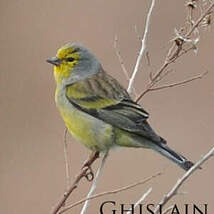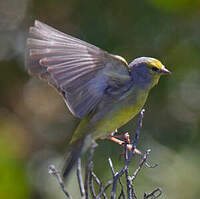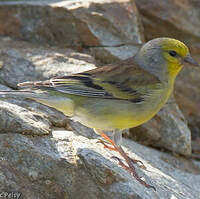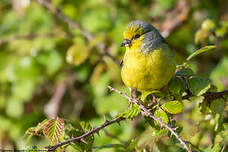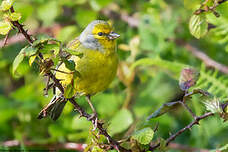Corsican Finch
Carduelis corsicana - Venturon corse
Identification
This species has long been considered a subspecies of the Mountain Finch (Carduelis citrinella). The two are very similar, but their distribution areas are completely separated. The Corsican Finch is bright yellow underneath (not yellowish green like the Mountain Finch) with a warm brown mantle striped in males (practically uniform in its congener). The female is paler, with thin streaks on the sides. In both sexes, the upper coverts are grayish (olive green for the v. montagnard).
Subspecific information monotypic species
Foreign names
- Venturon corse,
- Verderón corso,
- milheirinha-da-córsega,
- Korsenzeisig,
- korzikai csicsörke,
- Corsicaanse Citroensijs,
- Venturone corso,
- korsikansk siska,
- Korsikairisk,
- stehlík korzický,
- zvonohlík korsický,
- Brunrygget Citronsisken,
- korsikanhemppo,
- llucareta corsa,
- osetnik korsykański,
- Korsikas ģirlicis,
- Корсиканский вьюрок,
- コルシカヒワ,
- 科西嘉黄丝雀,
- korsikansk siska,
- 地中海絲雀,
Voice song and call
Habitat
In Corsica, the Corsican Finch can be observed in almost all habitats, from the coastal shrub to 2,250 m at Mont Cinto. It inhabits low shrubby areas, heaths, as well as forest edges, rocky areas dotted with bushes and wooded areas. Whilst avoiding agricultural areas, it can be found on the edges of villages, where gardens meet the bushes or the shrubland.
Behaviour character trait
The Corsican Finch species is considered to be sedentary, however, regular movements are observed between Corsica and Sardinia from April to May and in September. After the reproductive season, birds from the coast gradually move up in altitude according to food availability. Important flocks with several tens, or even hundreds of individuals can then be observed.
Dietfeeding habits
Reproduction nesting
According to the altitude, reproduction begins in March and lasts until June. The nest (a cup made of fine grass, moss, fur and feathers) is generally placed less than 3 m high in an evergreen shrub (juniper, holm oak, broom, brambles, etc.). It can be built higher in large pine trees. The two annual clutches range from 2 to 5 eggs.
Geographic range
Threats - protection
Sources of information
- IOC World Bird List (v14.2), Gill, F and D Donsker (Eds). 2024-04-18.
- Le guide ornitho : Le guide le plus complet des oiseaux d'Europe, d'Afrique du Nord et du Moyen-Orient : 900 espèces, Svensson, Mullarney, Zetterstrom
- Nouvel inventaire des oiseaux de France, Philippe J. Dubois, Pierre Le Maréchal, Georges Olioso, Pierre Yésou
- xeno-canto, Sharing bird sounds from around the world,
- Avibase, Lepage Denis
- HBW Alive,
- The internet Bird Collection,
- Birds of the Western Paleartic interactive, Cramp Simmons
- Hanbook of the birds of the world - Vol 15, del Hoyo J., Elliott A. Christie D.
- Genetic differences among mainland and insular forms of the Citril Finch Serinus citrinella, Pasquet E. Thibault J.-C.
- Atlas des oiseaux de France métropolitaine. Nidification et présence hivernale. , Issa Nidal et Muller Y
Other sources of interest
 Specification sheet created on
30/07/2023 by Georges Olioso
Specification sheet created on
30/07/2023 by Georges OliosoTranslation by AI Oiseaux.net
© 1996-2025 Oiseaux.net
- Accipitriformes
- Aegotheliformes
- Anseriformes
- Apodiformes
- Apterygiformes
- Bucerotiformes
- Caprimulgiformes
- Cariamiformes
- Casuariiformes
- Charadriiformes
- Ciconiiformes
- Coliiformes
- Columbiformes
- Coraciiformes
- Cuculiformes
- Eurypygiformes
- Falconiformes
- Galliformes
- Gaviiformes
- Gruiformes
- Leptosomiformes
- Mesitornithiformes
- Musophagiformes
- Nyctibiiformes
- Opisthocomiformes
- Otidiformes
- Passeriformes
- Pelecaniformes
- Phaethontiformes
- Phoenicopteriformes
- Piciformes
- Podargiformes
- Podicipediformes
- Procellariiformes
- Psittaciformes
- Pterocliformes
- Rheiformes
- Sphenisciformes
- Steatornithiformes
- Strigiformes
- Struthioniformes
- Suliformes
- Tinamiformes
- Trogoniformes





